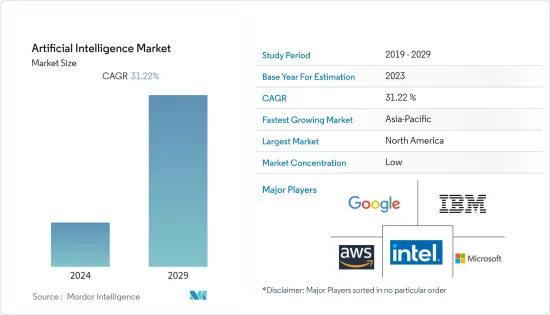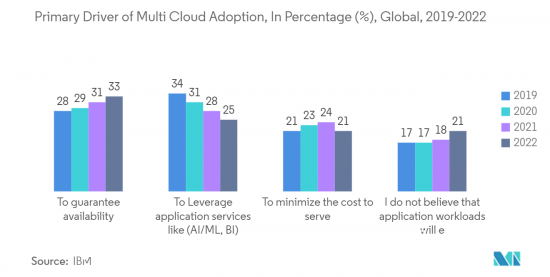PUBLISHER: Mordor Intelligence | PRODUCT CODE: 1406575

PUBLISHER: Mordor Intelligence | PRODUCT CODE: 1406575
Artificial Intelligence - Market Share Analysis, Industry Trends & Statistics, Growth Forecasts 2024 - 2029

The artificial intelligence market is expected to register a CAGR of 31.22% during the forecast period.
Key Highlights
- Artificial intelligence (AI), particularly computer vision and machine learning (ML), is transforming the landscape of industries. The artificial intelligence market is expanding globally due to breakthroughs in deep learning and data-driven AI, and the necessity to acquire robotic autonomy to compete in a global market is projected to promote the adoption of AI products and services.
- In recent years, the growing use of digital technologies and the Internet considerably aided the expansion of the worldwide AI industry. Technology breakthroughs in a variety of industries are constantly being fueled by the large research and development investments made by tech giants.
- The expansion of predictive analytics solutions based on AI-based ML technology is expected to boost the artificial intelligence market over the forecast period. Many end-user firms are using predictive modeling worldwide for industry planning and growth.
- With increased Internet penetration and new technology, there is a tremendous increase in the amount of data created globally. AI is being encouraged by technologies such as the Internet of Things, Industry 4.0, 5G, and others. Big data is the outcome of a massive increase in data created due to technological breakthroughs.
- COVID-19 significantly impacted the market. While certain industries witnessed an increase in AI adoption, others witnessed a decline. The Covid-19 debacle provided critical insights about digital transformation for company executives. One of the most compelling takeaways was the potential that data analytics and AI bring to a business.
- For example, AI enables the public sector to bring processes, people, and services online and encourages local, regional, and national governments to adopt AI. In only a few months, governments throughout the globe have learned to employ artificial intelligence as a weapon in combating the virus. This includes educating the public and screening patients to track and trace contacts.
- Employees need rapid assistance to be productive with the move to "work from anywhere," whether they have an IT problem, an HR request, or a question regarding the company's expenditure policy. Due to a lack of size or speed, traditional service desks can no longer provide round-the-clock assistance in real time to a hybrid workforce. Service desks often resolve employee issues in an average of three working days, which lowers engagement and productivity. To address these problems, in July 2022, Tata Consultancy Services (TCS) announced a partnership with Moveworks. This AI platform offers employees seamless multilingual support by querying their needs at any moment. Such initiatives are projected to boost the demand for digital transformation and help market growth in the post-COVID-19 scenario.
Artificial Intelligence Market Trends
Growth in Adoption of Cloud-based Applications and Services Drives the Market Growth
- Cloud-based solutions are an essential component of today's digital environment. The expanding trend of multi-cloud operation and the growing need for cloud-based intelligence services drive the demand in the market under study. The latest artificial intelligence (AI) technologies add unique and increased value to cloud computing. This aspect improves overall process viability and is necessary for incorporating new technology.
- AI software can also help bridge the gap between cloud computing and modern breakthroughs. It also assists in satisfying the needs of new enterprises and startups. According to IBM, In 2022, 25 percent of respondents said they were using multi-cloud to leverage different application services like AI/ML, big data analytics, business intelligence, IoT, etc.
- The continuous operations and infrastructure requirement raises the demand for hybrid computing models to reduce long-term costs, security, and scalability. To extend and manage IT, investment in hybrid public cloud deployment models that span private, public, and edge environments has flourished. For example, in February 2023, Oracle announced it would establish a third public cloud in Saudi Arabia to address the fast-expanding demand for its cloud services. The new cloud region, located in Riyadh, is part of Oracle's projected USD 1.5 billion investment to increase cloud infrastructure capabilities in the country.
- SAS, a pioneer in analytics, entered into an arrangement with Moro Hub to leverage Moro Hub's superior cloud services to strengthen its AI-based solutions for businesses in Dubai and accelerate its journey toward digital transformation. SAS announced cooperation with Moro Hub, a branch of Dubai Electricity and Water Authority's digital arm, Digital Dewa, in July 2022 to accomplish this. As part of the new arrangement, SAS will employ Moro Hub's multiple cloud services on a single platform to increase its data management products' agility, scalability, and security.
- Furthermore, due to its benefits, such as scalability, increased productivity, and cost reduction, the cloud method is gaining popularity in a variety of industries, such as financial services, e-commerce, industrial, and others.
- The use of cloud computing to power applications, such as 3D printing for outsourcing 3D prototypes, components, and products, is rapidly expanding. New platforms from 3D printing makers are also assisting cloud expansion. Markforged, a metal and carbon fiber 3D printer maker, recently introduced Digital Forge, an industrial 3D printing software platform. The platform is intended to connect all of the Markforged systems now in operation worldwide, which number in the thousands.

North America Holds Largest Market Share
- The United States has a robust innovation ecosystem supported by strategic federal investments in cutting-edge technology, in addition to the presence of forward-thinking scientists and entrepreneurs who come together from around the world and renowned research centers that have accelerated the development of artificial intelligence (AI) in the North American region.
- The industry is anticipated to benefit from many US government initiatives related to AI. For instance, the Expanding AI Innovation through Capacity Building and Part II program was launched by the US National Science Foundation in December 2022 in coordination with the US Department of Agriculture (USDA), the US Department of Homeland Security, the Science and Technology Directorate (US DHSTD), the National Institute of Standards and Technology (NIST), National Institute of Food and Agriculture (NIFA), and the US Department of Defense (US DoD), Office of the Under Secretary of Defense for Research and Engineering. Through capacity-building projects and collaboration within the NSF-led National AI Research Institutes ecosystem, ExpandAIseeks to significantly increase the participation of institutions that serve underrepresented groups in artificial intelligence education, research, and workforce development.
- Moreover, the United States has been working to formalize the National Artificial Intelligence (AI) Initiative, which concentrates on six strategic pillars: advancing trustworthy AI, enhancing AI innovation, enhancing current infrastructure through new technologies, developing new opportunities for education and training through AI, facilitating private and federal sector utilization of AI to improve current systems, and fostering an international environment that supports further advancements in AI.
- Further, in April 2022, the US Department of Commerce and the National Institute on Standards (NIST) announced members of the inaugural National Artificial Intelligence Advisory Committee (NAIAC) tasked with advising the Biden administration on how to proceed with the national AI governance efforts.
- The inclusion of the public and private sectors in the development and use of AI technology across several industries is also anticipated to support Canada's expanding need for AI. For example, in April 2022, an Ottawa-based business enhanced the effectiveness of virtual meetings with its AI-powered, human-like meeting assistant. Uncanny Lab Ltd.'s bluecap technology improves meetings for hosts and guests. Platforms for teleconferencing that the firm integrates with include Google Meets and Zoom. Automatic meeting transcriptions, review films, and succinct meeting summaries are among its fundamental capabilities that serve as a meeting assistant.
- Major corporations like Google, Facebook, and Uber have established core research laboratories that work with numerous institutions all over Canada thanks to the country's top researchers, vibrant start-ups, open immigration rules, considerable tax subsidies for R&D, and access to international markets. The Canadian government finances several initiatives to demonstrate Canada's leadership in AI through the Canadian Institute for Advanced Research (CIFAR).
Artificial Intelligence Industry Overview
The artificial intelligence market is highly fragmented, with the presence of major players like IBM Corporation, Intel Corporation, Microsoft Corporation, Google LLC (Alphabet Inc.), and Amazon Web Services Inc. Players in the market are adopting strategies such as partnerships, innovations, mergers, and acquisitions to enhance their product offerings and gain sustainable competitive advantage.
In July 2022, NBFC-giant HDFC on Tuesday announced its partnership with the leading customer relationship management (CRM) platform, Salesforce, to support its growth priorities. HDFC stated that Mulesoft's innovative API-led integration approach and low code integration capabilities would help the company innovate quickly around connecting systems and help create new experiences.
In July 2022, SAS and Basserah partnered to deliver leading data analytics and AI solutions to Saudi businesses. With this partnership, both companies are focusing on data and robotics process automation for growth opportunities in the Kingdom of Saudi Arabia.
Additional Benefits:
- The market estimate (ME) sheet in Excel format
- 3 months of analyst support
TABLE OF CONTENTS
1 INTRODUCTION
- 1.1 Study Assumptions and Market Definition
- 1.2 Scope of the Study
2 RESEARCH METHODOLOGY
3 EXECUTIVE SUMMARY
4 MARKET INSIGHTS
- 4.1 Market Overview
- 4.2 Industry Attractiveness - Porter's Five Forces Analysis
- 4.2.1 Bargaining Power of Suppliers
- 4.2.2 Bargaining Power of Buyers
- 4.2.3 Threat of New Entrants
- 4.2.4 Threat of Substitutes
- 4.2.5 Intensity of Competitive Rivalry
- 4.3 Technology Snapshot
- 4.3.1 Machine Learning
- 4.3.2 Computer Vision
- 4.3.3 Natural Language Processing (NLP)
- 4.3.4 Context-aware Computing and Other Technologies
5 MARKET DYNAMICS
- 5.1 Market Drivers
- 5.1.1 Increasing Demand for Predictive Analytics Solutions
- 5.1.2 Massive Growth in Data Generation due to Technological Advancements
- 5.1.3 Growth in Adoption of Cloud-based Applications and Services
- 5.1.4 Rising Demand for Enhanced Consumer Experience
- 5.2 Market Challenges
- 5.2.1 High Initial Costs and Concerns over Replacement of Human Workforce
- 5.2.2 Lack of Skilled and Expert AI Technicians
- 5.2.3 Concerns Regarding Data Privacy
- 5.3 Key Use-cases/Applications
- 5.3.1 Sales and Marketing
- 5.3.2 Logistics Management
- 5.3.3 Automated Customer Service
- 5.3.4 Automated Threat Intelligence
- 5.3.5 IT Automation, Among Others
- 5.4 Impact of COVID-19 on the Market
6 MARKET SEGMENTATION
- 6.1 By Components
- 6.1.1 Hardware
- 6.1.2 Software and Services
- 6.2 By End-user Industry
- 6.2.1 BFSI
- 6.2.2 Fashion and Retail
- 6.2.3 Healthcare and Lifesciences
- 6.2.4 Manufacturing
- 6.2.5 Automotive
- 6.2.6 Aerospace and Defense
- 6.2.7 Construction
- 6.2.8 Other End-user Industries
- 6.3 By Geography
- 6.3.1 North America
- 6.3.1.1 United States
- 6.3.1.2 Canada
- 6.3.2 Europe
- 6.3.2.1 United Kingdom
- 6.3.2.2 Germany
- 6.3.2.3 France
- 6.3.2.4 Rest of Europe
- 6.3.3 Asia Pacific
- 6.3.3.1 China
- 6.3.3.2 India
- 6.3.3.3 Japan
- 6.3.3.4 South Korea
- 6.3.3.5 Rest of Asia Pacific
- 6.3.4 Latin America
- 6.3.5 Middle East and Africa
- 6.3.1 North America
7 COMPETITIVE LANDSCAPE
- 7.1 Company Profiles
- 7.1.1 IBM Corporation
- 7.1.2 Intel Corporation
- 7.1.3 Microsoft Corporation
- 7.1.4 Google LLC (Alphabet Inc.)
- 7.1.5 Amazon Web Services Inc. (amazon.com Inc.)
- 7.1.6 Oracle Corporation
- 7.1.7 Salesforce Inc.
- 7.1.8 SAP SE
- 7.1.9 SAS Institute Inc.
- 7.1.10 Cisco Systems Inc.
- 7.1.11 Siemens AG
- 7.1.12 Nvidia Corporation
- 7.1.13 Hewlett Packard Enterprise
8 INVESTMENT ANALYSIS
9 MARKET OPPORTUNITIES AND FUTURE TRENDS




